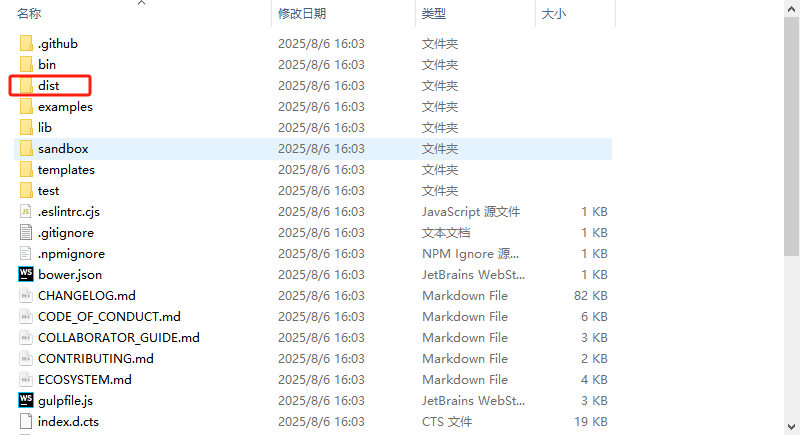1、什么是 Axios?
Axios 是一个基于 Promise 的 HTTP 客户端,用于浏览器和 Node.js 环境,用来发送 HTTP 请求(如 GET、POST、PUT、DELETE 等)。
它常用于:
- 向后台 API 发送请求获取数据
- 提交表单数据
- 上传文件
- 与 RESTful API 进行交互
在 Vue.js项目中,Axios 是最流行、最推荐的 HTTP 请求库之一,用来替代原生 fetch,因为它功能更强大、使用更方便、支持拦截器、取消请求等高级功能。
中文网地址:axios中文网|axios API 中文文档 | axios
2、Axios特性
- 从浏览器中创建XMLHttpRequests
- 从 node.js 创建http请求
- 支持 Promise API
- 拦截请求和响应
- 转换请求数据和响应数据
- 取消请求
- 自动转换 JSON 数据
- 客户端支持防御XSRF
3、Axios下载
1、使用 npm 安装
npm install axios2、使用 yarn 安装
yarn add axios3、直接通过 CDN 引入
<script src="https://cdn.jsdelivr.net/npm/axios/dist/axios.min.js"></script>4、下载Js文件
Gitee下载地址:https://gitee.com/mirrors/axios

4、Axios 的基本用法
1.、发送 GET 请求
import axios from 'axios'
// 方式1:直接使用 then/catch
axios.get('https://localhost:8081/list/1')
.then(response => {
console.log('获取的数据:', response.data)
})
.catch(error => {
console.error('请求出错:', error)
})
// 方式2:使用 async/await(推荐)
async function fetchData() {
try {
const response = await axios.get('https://localhost:8081/list/1')
console.log('获取的数据:', response.data)
} catch (error) {
console.error('请求失败:', error)
}
}
fetchData()2、发送 POST 请求
axios.post('https://localhost:8081/list', {
title: 'Hello Axios',
body: 'This is a post sent by Axios',
userId: 1
})
.then(response => {
console.log('创建成功:', response.data)
})
.catch(error => {
console.error('创建失败:', error)
})3、执行多个并发请求
function getUserAccount() {
return axios.get('/user/12345');
}
function getUserPermissions() {
return axios.get('/user/12345/permissions');
}
axios.all([getUserAccount(), getUserPermissions()])
.then(axios.spread(function (acct, perms) {
// 两个请求现在都执行完成
}));4、带参数的 GET 请求(Query 参数)
axios.get('https://localhost:8081/posts', {
params: {
userId: 1
}
})
.then(response => {
console.log(response.data) // 获取 userId 为 1 的所有文章
})
//实际请求的 URL 类似:
//https://localhost:8081/posts?userId=15、Axios 常用配置项
在发送请求时,可以传入一个 配置对象,常用选项包括:
axios({
method: 'post', // 请求方法:get, post, put, delete 等
url: '/user/12345', // 请求地址
data: { // 请求体(通常用于 POST、PUT)
firstName: 'John',
lastName: 'Doe'
},
params: { // URL 查询参数(GET 参数)
ID: 12345
},
headers: { // 自定义请求头
'X-Custom-Header': 'foobar'
},
timeout: 5000 // 请求超时时间(毫秒)
})6、Axios 实例
通常我们不会直接使用全局的 axios,而是创建一个 Axios 实例,这样可以:
- 设置 基础 URL
- 设置 默认请求头(如 Token)
- 统一的 超时时间
- 更好的 模块化管理
创建实例
import axios from 'axios'
// 创建一个 axios 实例
const api = axios.create({
baseURL: 'https://localhost:8081', // 基础路径
timeout: 5000, // 请求超时时间
headers: { 'Content-Type': 'application/json' }
})使用实例发送请求
// GET
api.get('/posts/1')
.then(response => {
console.log(response.data)
})
// POST
api.post('/posts', {
title: 'Hello',
body: 'World',
userId: 1
})7、请求 & 响应拦截器
在请求发出去之前或收到响应之后,统一做一些处理,比如:
- 添加 token 到请求头
- 统一处理错误
- 加载状态控制
1、请求拦截器(Request Interceptor)
api.interceptors.request.use(
config => {
// 在发送请求之前做些什么
const token = localStorage.getItem('token')
if (token) {
config.headers.Authorization = `Bearer ${token}`
}
console.log('请求配置:', config)
return config // 必须返回 config
},
error => {
// 请求错误时做些什么
return Promise.reject(error)
}
)2、响应拦截器(Response Interceptor)
api.interceptors.response.use(
response => {
// 对响应数据做点什么,比如只返回 data 部分
return response.data // 直接返回数据部分,简化后续处理
},
error => {
// 对响应错误做点什么
if (error.response) {
switch (error.response.status) {
case 401:
console.error('未授权,请登录')
break
case 404:
console.error('请求资源不存在')
break
case 500:
console.error('服务器错误')
break
default:
console.error('请求错误:', error.response.status)
}
} else {
console.error('网络或未知错误:', error.message)
}
return Promise.reject(error)
}
)8、在 Vue 项目中使用 Axios
在实际的 Vue 项目中,通常会:
1、封装 axios(创建实例 + 拦截器)
2、在 main.js 或插件中全局挂载(可选)
3、在组件或 API 模块中调用
项目结构:
src/
├── api/
│ └── user.js # 用户相关的接口
├── utils/
│ └── request.js # axios 实例和基础配置
└── components/
└── ...1、创建 axios 实例(utils/request.js)
// utils/request.js
import axios from 'axios'
const request = axios.create({
baseURL: 'https://localhost:8081', // 你的 API 地址
timeout: 5000
})
// 请求拦截器
request.interceptors.request.use(
config => {
const token = localStorage.getItem('token')
if (token) {
config.headers.Authorization = `Bearer ${token}`
}
return config
},
error => Promise.reject(error)
)
// 响应拦截器
request.interceptors.response.use(
response => response.data, // 直接返回数据部分
error => {
console.error('请求出错:', error)
return Promise.reject(error)
}
)
export default request2、封装 API 请求(api/user.js)
// api/user.js
import request from '@/utils/request'
// 获取用户信息
export function getUser(id) {
return request.get(`/users/${id}`)
}
// 创建用户
export function createUser(data) {
return request.post('/users', data)
}3、在 Vue 组件中使用
<template>
<div>
<button @click="fetchUser">获取用户</button>
<p v-if="user">用户名: {{ user.name }}</p>
</div>
</template>
<script>
import { getUser } from '@/api/user'
export default {
data() {
return {
user: null
}
},
methods: {
async fetchUser() {
try {
const res = await getUser(1) // 获取 ID 为 1 的用户
this.user = res
} catch (error) {
console.error('获取用户失败:', error)
}
}
}
}
</script>9、Vue 3 Composition API 中使用 Axios
如果使用 Vue 3 的 <script setup>,代码会更简洁:
<script setup>
import { ref } from 'vue'
import { getUser } from '@/api/user'
const user = ref(null)
const fetchUser = async () => {
try {
const res = await getUser(1)
user.value = res
} catch (error) {
console.error('获取失败', error)
}
}
</script>
<template>
<button @click="fetchUser">获取用户</button>
<p v-if="user">用户名: {{ user.name }}</p>
</template>